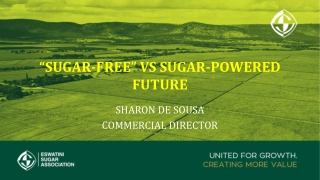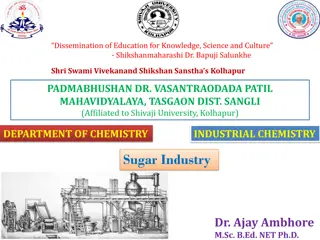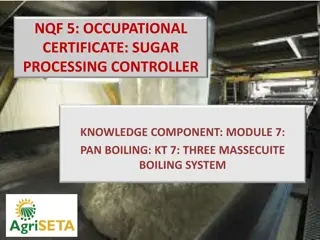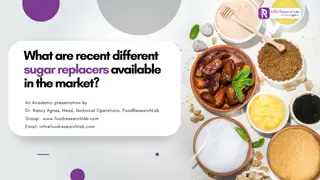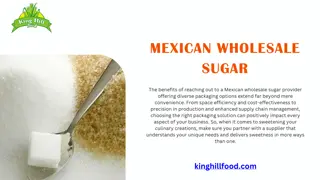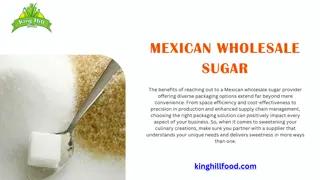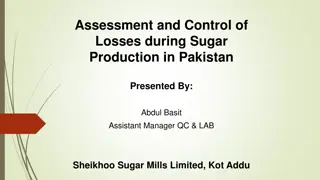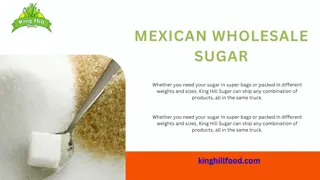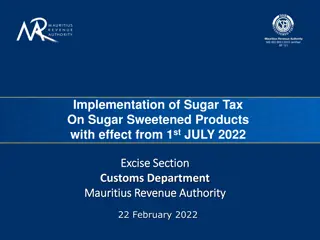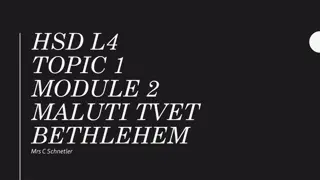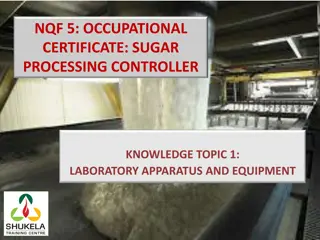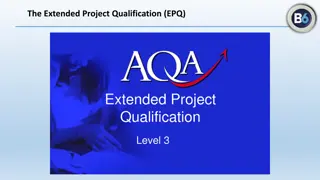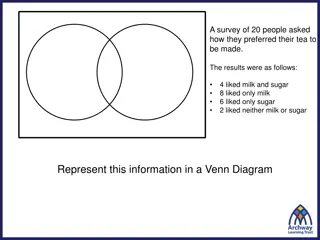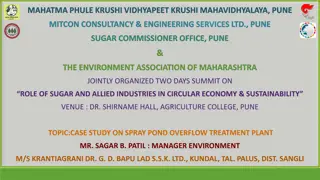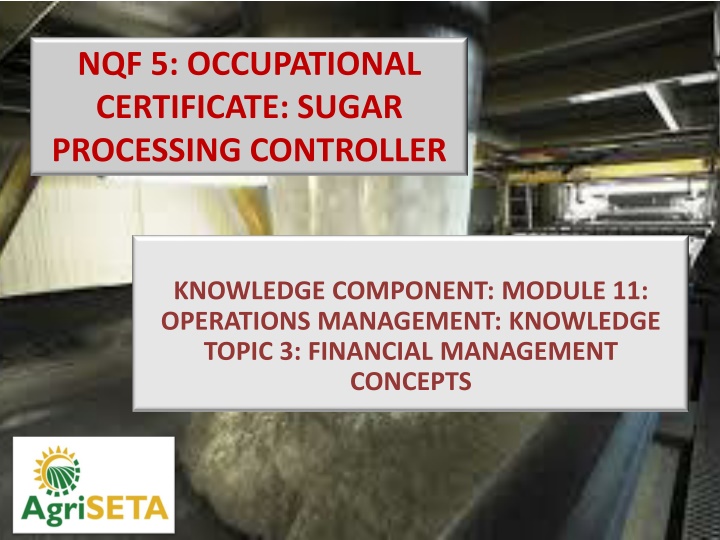
Advanced Financial Management Concepts in Sugar Processing Operations
Explore budgeting concepts crucial for effective financial management in sugar processing operations, including the significance of cash flow budgets and their impact on day-to-day decision-making and long-term planning.
Uploaded on | 2 Views
Download Presentation

Please find below an Image/Link to download the presentation.
The content on the website is provided AS IS for your information and personal use only. It may not be sold, licensed, or shared on other websites without obtaining consent from the author. If you encounter any issues during the download, it is possible that the publisher has removed the file from their server.
You are allowed to download the files provided on this website for personal or commercial use, subject to the condition that they are used lawfully. All files are the property of their respective owners.
The content on the website is provided AS IS for your information and personal use only. It may not be sold, licensed, or shared on other websites without obtaining consent from the author.
E N D
Presentation Transcript
NQF 5: OCCUPATIONAL CERTIFICATE: SUGAR PROCESSING CONTROLLER KNOWLEDGE COMPONENT: MODULE 11: OPERATIONS MANAGEMENT: KNOWLEDGE TOPIC 3: FINANCIAL MANAGEMENT CONCEPTS
Budgeting Concepts Budgeting is an essential financial management tool which involves planning and controlling of finances for a specific period. Without a budget it will be very difficult for plant managers to know how much money can be spent on particular items, and whether it is necessary to cut costs, or find other sources of income. But budgets are only worthwhile if they are used in the day-to-day management of the business. Annual budgets are too blunt a tool to be used as a day-to-day management tool. Monthly budgets are much more useful for this purpose. Income and direct expenditure in the Sugar Mill is seasonal by nature. Even though an annual budget can show a positive picture, it is probable that a monthly budget will show that some months might show a shortfall. The plant manager needs to be aware of this, so that these months can be planned for.
Budgeting Concepts (cont.) There are two ways to budget. The first is to simply base a budget on the income statement, which is useful because in this way we can project the net profit or loss that the factory is projected to generate over time, and we can also project what the balance sheet will look like at the end of each year. We can also measure the impact on the profitability of non-cash items such as depreciation. Lastly, income statement budgets allow us to project the amounts that will have to be paid for income tax.
Budgeting Concepts (cont.) But for day-to-day financial management, a cash flow budget is much more useful. A cash flow budget is based on the cash flow statement, and is used to project: When you should expect income and when you will incur expenses, based on seasonality of your enterprise. Whether the business will have enough cash to meet its commitments every month, or whether a loan or an overdraft facility may be necessary to carry it through. It may also be necessary to negotiate payment terms with creditors. The capital requirements of the business. It may, for instance, be necessary to postpone buying expensive new equipment or spend money on infrastructure. Alternatively, the plant manager can decide to rather lease capital items such as vehicles.
Budgeting Concepts (cont.) The cash flow budget may indicate to management that an alternative income source is needed that provides more regular income. This may prompt management to change their product range, or to look for alternative uses for the product, or to seek new clients. The cash flow budget will also help in forecasting the costs of such an operation (i.e. the effects of implementing such a change). Cash flow budgets help with preventing spending money impulsively on items that are not necessary or that the factory cannot afford at a particular time. It is essential that a cash flow budget must be used as a management tool on a regular basis.
Budgeting Control The main steps in the company budgetary control process are as follows: Definition of objectives Allocation of responsibilities for achievement of objectives Statement of policies and strategies necessary to achieve the objectives Budget preparation calculation of likely results Budget approval Implementation of policies and strategies The Operations Manager will most likely be drawn into this budgeting control process and must be able to provide inputs as regards efficiency of the plant and measures for improvement.
Cost Estimates and Calculations Fixed costs versus Variable costs A cost in a business is the total money, time and resources associated with a purchase or activity. In order to produce a product in an enterprise, total costs of that production include fixed and variable costs. Fixed costs are those costs that are constant and have to be paid regularly, although their value may change over time, for example, rent, electricity, salaries, etc. Variable costs are those that change depending on the time of year and what is happening in the factory and out on the production farms, for example, raw materials, chemicals, transport costs, packaging, etc.
Cost Estimates and Calculations (cont.) Fixed costs versus Variable costs (cont.) Some costs are a little more difficult to classify. For instance, although salaries are a fixed cost, wages paid to seasonal workers is seen as a variable cost. Electricity is another one that is a little difficult because the amount paid for electricity can vary quite a lot from month to month, but it is still seen as a fixed cost because it has to be paid every month. Because variable costs depend on the factory activities and inputs and outputs and therefore depend on the production plans, they can be controlled in the short term through good planning. Variable costs can also usually be allocated to particular production units or divisions in the factory. Thus, a manager can compare the variable costs (or the efficiency of their use) between different divisions on the same factory floor.
Cost Estimates and Calculations (cont.) Direct versus Indirect costs Indirect, or overhead, costs are those which cannot be directly linked to the production of the product that the Sugar Mill sells. Examples of overhead costs are rent, water and electricity, building maintenance, insurance, administration and management salaries, stationery, levies, accounting fees, bank charges, etc. Indirect costs stay the same, no matter how much of the product is being produced or how much income is being generated from product sales. For example, salaries for management and administration staff must still be paid, whether the factory has a lot of product to sell that will generate a lot of income, or whether there has been production failures and very little income.
Cost Estimates and Calculations (cont.) Direct versus Indirect costs (cont.) Direct costs are directly related to the production of the product that generates the income. Includes costs such as production salaries, chemicals, protective clothing, tools and equipment, packaging costs, fuel for logistics, etc. Direct costs can vary depending on the amount of product produced. If we use the example above, packaging costs and chemical costs will depend on the amount of product processed, and will be lower when less product is being produced. Equipment (not production tools) and infrastructure are not seen as either direct or indirect costs, but is called capital expenditure.
The Income Statement The income statement captures all the income and expenditure information of the enterprise and from these basic records the following figures can be calculated: Gross Value of Production (for each division of the enterprise) Directly allocatable variable cost (of each division of the enterprise) Sundry factory income Gross margins (of each division of the enterprise) Overhead costs External factor costs (e.g. interest paid on borrowed capital, cost of hired equipment) Net increase in value of assets over liabilities due to non- production activities (A)
The Income Statement (cont.) Using the above figures the following figures can be calculated: Gross Value of Production for the factory Total directly allocatable variable costs Total Gross Margin for the factory Net Factory Income (NFI) (B) Factory Profit or Loss (NFP) (C) Growth in Net worth (D)
Cash Flow Budgets A cash flow budget is used to determine the future cash flow for a specific business and is thus an important planning tool. When planning the next few years of your operation, a cash flow budget will assist you to determine: When you should expect income (based on seasonality of your enterprise) and when you will incur expenses Whether the business will be profitable and whether some loans may be necessary to run the business (and make the profit) What capital requirements are needed (perhaps new equipment, new infrastructure etc.) How much credit (overdraft facilities) you will need and how you should schedule your repayments.
Cash Flow Budgets (cont.) Cash flow budgets are important to management because, generally, mills have seasonal expenses and may need to plan to store product to ensure year-round sales. Furthermore, inputs such as chemicals and packaging may need to be purchased before the season starts, or equipment may need to be maintained before the season starts. Thus, a cash flow budget allows management to determine how much money they may need to borrow at different times during the year, and it will help them determine when they will have the income to repay those loans (with interest).
Cash Flow Budgets (cont.) A cash flow budget also allows management to plan when to buy large items in times where there are cash surpluses in this way they can avoid the expense of borrowed money. They could also alleviate times of cash shortage by selling unnecessary capital items (like old tools,trucks or equipment). A cash flow budget also allows management to choose which products to produce to ensure that factory income is more regular (Some mills have expanded their product ranges to include more speciality or confectionery-type products).
Cash Flow Budgets (cont.) A cash-flow budget indicates the following: When and how much cash income is received When and how much cash expenses are incurred When cash surpluses and cash shortfalls occur When and how much credit should be obtained What the credit is needed for The time and amount of repayments The cash flow budget concentrates on the viability of various plans and is a useful planning tool.
Cash Flow Budgets (cont.) Advantages of cashflow budgets It provides a guide for factory expenses. Management knows how much money will come into the business and when this will happen and how much will be spent and on what it will be spent. It helps to forecast and plan large expenses. It helps to prevent spontaneous and impulsive purchases by management. It facilitates communication between the financier and management. Bank managers often require information such as is contained in the cash flow budget before loans are granted.
Cash Flow Budgets (cont.) Disadvantages of cashflow budgets Information has to be obtained from several sources Unforeseen future events can disrupt the financial plan. However, any plan is better than no plan at all. Compiling a cash flow budget is time-consuming. If the information used was unreliable, such a budget can be misleading rather than helpful.
Cost Management It is of utmost importance to ensure quality products are produced at all times to minimize the risks of incurring unnecessary costs that might occur due to: Waste Re-work Recall
Cost Management - Waste Definition: The production of unwanted materials as a by-product of economic processes. Waste could be caused by Poor work performance, Errors in the manufacturing process, Poor organization and Poor communication Waste can occur: In the factory, Between divisions of the factory and Between raw material suppliers (cane farmers) and the factory. Waste can be considered the manufacture of materials that have no economic value to the business, or materials that have a reduced income value to the business, or materials that create a financial burden to the business (i.e. the cost of its removal or destruction).
Cost Management Waste (cont.) Wastes in a Sugar Mill can be classified as: Defects (Information and products that are incomplete or inaccurate) Overproduction (Making more of something than is needed) Waiting (for information, equipment, materials, parts or people) Non-Utilized Talent (Not properly utilizing people s experience, skills, knowledge or creativity employees unable to make decisions, employees not fully trained, skilled employees doing unskilled tasks) Transportation (unnecessary movement of materials, people, information or equipment), Inventory (Accumulation of parts, information, applications, product which is beyond what is required by the customer), Motion (Any movement by people that is not of value such as unnecessary walking between equipment, switching equipment applications) Extra-Processing (Any steps that do not add value in the eyes of the customer extra detail, extra features, extra reporting to achieve the end result). This acronym spells DOWNTIME
Cost Management Rework Definition: Correcting of defective, failed, or non-conforming product, during or after inspection. Rework includes all follow-on efforts such as remelting, re- packaging, etc. There are several reasons why a sugar product could be found to be defective or requiring rework: Equipment malfunction or human error Product specification not correctly communicated (at all or in a timely manner) Product specification manufacturing change not implemented properly Product damaged in transit (during delivery to client) Product damaged in use (perhaps spoiled by water damage in a warehouse)
Cost Management Rework (cont.) How to reduce rework: Update and maintain a daily Operational Management Plan which speaks to the needs of management and clients on a daily basis (or jobs basis). Communicate quickly & completely with the manufacturing team. Be available. Changes mid-stream cause significant disruption if not planned and managed correctly. Be proactive. Preempt quality control issues by taking a proactive rather than a reactive position. Make regular factory inspections to identify problems and to look for ways to improve processes. You want to find the root cause of the issue and resolve it as early and as simply as possible.
Cost Management Rework (cont.) How to reduce rework (cont.): Could the problem be solved by: Acquiring new equipment and fixtures? Improved employee training? Software upgrades or additions? Greater attention during manufacturing stages? More emphasis on pre-production processes? Revised packaging/handling procedures? Implement and emphasize quality control procedures. The stringent application of the Safety, Health, Environment, Risk and Quality Control policies of the factory will assist to reduce such incidences.
Cost Management Rework (cont.) How to reduce rework (cont.): Create a Scrap Materials Plan. It is always preferable to rework the product, but sometimes scrapping is unavoidable. In the event you need to scrap, try to reduce the amount of waste as much as possible. Depending on the material or location: Can you avoid dumping fees? Can the product be repurposed? Can parts of the product be recycled?
Cost Management Recall A product recall is a request from a manufacturer to return a product after the discovery of safety issues or product defects that might endanger the consumer or put the manufacturer or clients (such as beverage companies) at risk of legal action. A recall is an effort to limit ruination of the factory s image and limit liability for negligence, which can cause significant legal costs. It can be difficult, if not impossible, to determine how costly can be releasing to the consumer a product that could endanger someone's life and the economic loss resulting from unwanted publicity.
Cost Management Recall (cont.) Recalls are costly. Costs include having to handle the recalled product (including transport costs), replacing it, the cost of investigation of the rejected or recalled product and possibly being held financially responsible for the consequences of the recalled product. The stringent application of the Safety, Health, Environment, Risk and Quality Control policies of the factory will assist to reduce such incidences.
Financial Source Documents Every Sugar Factory is a business enterprise. This means that a business owner/manager is in this business so that he can make money. To be able to assess whether the production system (the factory) is viable at any time, records must be kept of all financial transactions. These records can then be used to assess how the business is doing and to plan for the future of the business.
Financial Source Documents (cont.) The source records needed by a factory, the financial statements that can be generated by these documents, and the financial analyses that can be done to interpret the results. Gather, arrange and process information Record statements Physical inventory Depreciation schedule Record of accounts receivable and accounts payable Record of receipts Record of expenditure Labour records Machinery reports Physical production records Analyse and interpret the results Financial statements Financial analyses Solvability Liquidity Profitability Diagnostic analyses Investment standards Labour Machinery Product Balance sheet Income statement Cash flow statement

